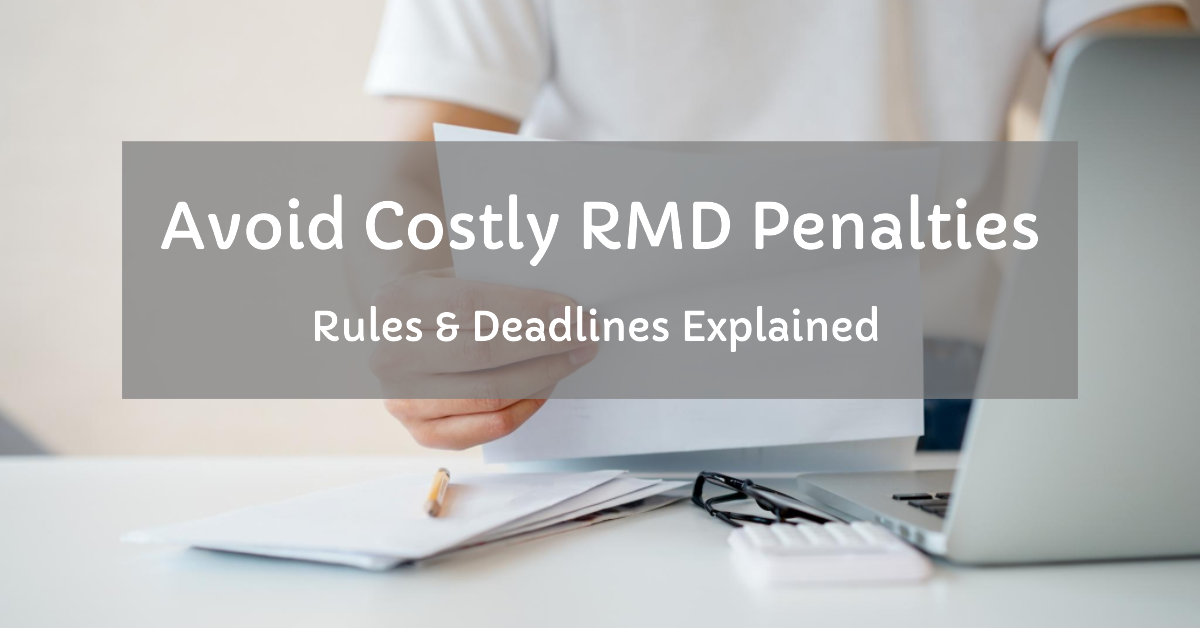Avoid Costly RMD Penalties: Essential Rules and Deadlines Explained
For many federal employees and military personnel approaching retirement, the rules around Required Minimum Distributions (RMDs) can feel daunting. After all, there’s no flexibility about whether you have to take them—you either withdraw the correct amount or risk a potentially hefty RMD penalty. Understanding the most pressing RMD deadlines, how they’re calculated, and recent legislative changes (New RMD Provisions in 2023) can help you avoid expensive missteps while preserving more of your hard-earned savings.
Why RMDs Matter for Federal Retirees
Retirement accounts such as Traditional IRAs, the Thrift Savings Plan (TSP), and other tax-deferred plans allow funds to grow without taxes on gains year to year. But the government eventually wants its share of that tax revenue, so you must begin taking RMDs at a certain age. The problem is that if you miss the RMD deadline or fail to withdraw enough, you may face a penalty of up to 25% of the shortfall. Although recent legislation reduced this penalty from 50%, it’s still high enough that it pays—literally—to stay compliant.
Federal employees typically have several different types of retirement accounts, including the TSP and possibly additional IRAs. Tracking each account’s required withdrawal calculations can get complicated. This is where thorough planning and coordinated advice become essential. Failing to plan properly, or misunderstanding how RMDs work when you’re still employed after age 73, can lead to avoidable mistakes.
RMD Basics: Which Accounts and Why?
RMDs apply to tax-deferred accounts such as:
• Traditional IRAs (including SEP and SIMPLE IRAs)• 401(k) plans, 403(b) plans, 457(b) plans, and the Traditional TSP• Inherited IRAs and employer-sponsored retirement plans
Roth IRAs, however, are not subject to RMDs during the owner’s lifetime, so they’re often an appealing way to reduce taxable distributions in retirement. Roth 401(k) and Roth TSP accounts had RMD requirements in the past, but legislative changes now generally remove these RMDs for the original account owner starting in 2024. This distinction can be especially helpful for those who want to minimize taxable income.
Overall, RMDs exist to ensure that the IRS eventually collects tax revenue on money that was allowed to grow tax-free over your working years. While that’s straightforward as a concept, the devil is in the details—especially when the laws around RMDs keep evolving. For more on how RMD start ages and calculations can vary, see IRA Required Minimum Distribution: Start Age and Calculations.
When Does the Clock Start? Age Threshold and Future Shifts
The current rule states that once you turn 73 (for individuals born between 1951 and 1959), you generally must take your first RMD by April 1 of the year following that birthday. That means if you turn 73 in 2024, your first RMD is due by April 1, 2025. Legislatively, the threshold is set to increase to age 75 for those born in 1960 or later, beginning in 2033. Although there has been discussion about RMD rules 2025 and further clarifications, recent IRS notices have delayed final regulations until at least 2026, so changes may still be on the horizon. For a look ahead, check out 2025 RMD Rules: Key Changes for Retirees.
Whether you must act on the year you turn 73 or 75 depends on your birth year. Checking which rule applies to you is a crucial early step, since missing even one deadline can lead to a significant rmd penalty. Also remember: if you continue to work past your required age, some employer-sponsored plans (including the TSP) allow you to delay RMDs until you retire, provided you don’t own more than 5% of the company employing you. That said, this “still working” exception does not apply to IRAs.
RMD Start Ages and Key Deadlines
Here’s a quick snapshot of the ages and deadlines that federal employees typically watch out for:
| Birth Year Range | RMD Start Age | First RMD Deadline | Subsequent RMD Deadline |
|---|---|---|---|
| 1951-1959 | 73 | April 1 after you turn 73 | December 31 each year after |
| 1960 or later | 75 | April 1 after you turn 75 (starting 2033) | December 31 each year after |
Federal employees should note that delaying your first withdrawal until the following April 1 can create a situation where you’re forced to take two distributions in the same tax year (one for turning 73, plus the next for age 74), potentially accelerating your taxable income. This might push you into a higher tax bracket, so strategic planning is key.
Critical RMD Deadlines
Many retirees don’t realize their first RMD has a different deadline from the rest. Specifically, if you turned 73 this year, you have until April 1 of next year to take the first withdrawal. Although that’s a welcome grace period for some, it can create unintended tax consequences. Some retirees prefer taking the first RMD by December 31 of the same year they turn 73 to avoid the double-hit scenario.
For all subsequent years, you must take the RMD by December 31. If you don’t, you risk triggering that newly lowered but still painful rmd penalty of 25%. The distribution you miss will also remain taxable when you do finally take it, so you don’t escape the tax bill by missing a deadline—you only add a penalty on top. If by chance you do miss a year, correcting it quickly and filing IRS Form 5329 might secure a penalty waiver if you can show a reasonable cause and that you withdrew the missed RMD amount as soon as possible.
How RMDs Are Calculated
The IRS uses your prior year’s account balance and applies a life-expectancy factor to determine your RMD amount. Each year, you look at the account’s value as of December 31, then divide that figure by the distribution period, which the IRS publishes in tables. These tables are designed to reflect how many years you’re expected to live, although for inherited accounts, exceptions and different rules may apply.
If you have more than one IRA, you must calculate each account’s RMD separately but you’re typically allowed to withdraw the total RMD amount from one or more of those IRAs. For federal employees with multiple TSP and IRA accounts, coordination is critical. Note that each 401(k) or 403(b) plan may require separate withdrawals. Understanding which rules apply to your mix of accounts will save you time and help you avoid confusion. In fact, TSP RMD pitfalls can crop up if you’re not aware of the plan-specific requirements.
Sample RMD Calculations
It can help to see how these numbers might look in practice:
| Prior Year-End Balance | Life Expectancy Factor | RMD Amount (Balance ÷ Factor) | Notes |
|---|---|---|---|
| $200,000 | 26.5 | $7,547.17 | Example for a 73-year-old |
| $400,000 | 24.6 | $16,260.16 | Example for a 75-year-old |
To generate these amounts, you’d use the IRS life-expectancy tables, which may change periodically. The key is to stay on top of the correct factor for your age and particular situation.
The RMD Penalty and Steps to Avoid It
Before 2023, failing to withdraw your full RMD by the deadline triggered a 50% penalty on the shortfall. Recent legislative updates through the SECURE 2.0 Act reduced that penalty to 25%. While 25% is certainly better than 50%, it’s still large enough to motivate anyone to get serious about meeting all rmd deadline obligations.
There’s another partial benefit under the new rules: if you identify the shortfall quickly, withdraw it, and file Form 5329 requesting a waiver, the penalty can sometimes be lowered to 10%. Good record-keeping and prompt action are your allies here. Remember, the last thing you want to do in retirement is give away a chunk of your savings to the IRS simply because you missed a due date. If you’d like to know how RMDs can also affect your Medicare premiums, see this cautionary guide.
Strategies to Stay Compliant
There are a few ways you can ensure you never miss your RMD and never incur an rmd penalty:
• Enroll in automatic withdrawals. Many financial institutions offer an “automate my RMD” service that sends the proper distribution to your bank every year around the same time.• Mark your calendar. Whether you go by December 31 each year (for subsequent RMDs) or April 1 for your initial start, scheduling reminders is an easy win.• Consider taking it early. Some retirees prefer taking the withdrawal soon after January 1 rather than letting it ride all year. This eliminates the risk of forgetting.• Seek personalized advice. An experienced financial planner can help you coordinate RMDs across all accounts and possibly reduce taxes through strategies like Roth conversions or Qualified Charitable Distributions (QCDs).
For federal employees seeking tailored support, we invite you to sign up for one of our free Federal Retirement Planning Workshops. These sessions cover the entire scope of federal benefits, including ways to streamline RMDs so you aren’t left scrambling each December.
Special Cases and Future Considerations
Legislation continues to shape rmd rules. While there’s talk about more changes impacting rmd rules 2025, final regulations have been delayed until at least 2026. This means more shifts could be on the horizon, affecting how and when distributions need to be taken. Staying informed will help you stay ahead.
Additionally, if you’re still employed at 73 (or 75, once that applies), you may benefit from the “still working exception” under your federal or agency-sponsored plan. However, this generally doesn’t carry over to IRAs. Federal employees who own less than 5% of the agency employing them may delay RMDs from that particular plan, but not from outside IRAs. That’s why having a clear sense of every retirement account you hold is so important.
An especially tricky area is inherited IRAs, where non-spouse beneficiaries often face a 10-year withdrawal rule under newer guidelines. If you inherited an IRA from a parent or relative who passed away in 2020 or later, you might need to empty the account by the end of the 10th year following the owner’s death. If you’re a “qualified” or “eligible” designated beneficiary, you may have additional options for spreading out distributions. For more on this, see Calculating Your Inherited IRA RMD.
Planning Now to Avoid Future Headaches
RMD mistakes can be expensive and stressful, but good planning eliminates most of the risk. By knowing exactly when you must make your withdrawals, how much, and from which accounts, you keep more of your money in your pocket. Along the way, you can explore strategic moves—like Roth conversions—to potentially lighten the RMD load later on.
At PlanWell, we’ve developed the Fed-Expert Financial Blueprint to help federal employees retire confidently. Because our team holds ChFEBC, CFP, and AIF designations, we understand the nuances of government benefits and how they integrate with your personal retirement income strategies. When it’s time to tackle RMD details, we’ll walk you through the process step by step, ensuring there aren’t any surprises come tax time. Learn more about working with a financial advisor who specializes in federal benefits.
Your Next Steps
As you approach your RMD age, remember that the transition can have ripple effects on your annual tax liability. Although it may seem like just one more task in retirement, an RMD strategy woven into your broader financial picture can make your golden years much more comfortable.
If you’d like guidance on how to manage the multiple moving pieces of federal benefits, TSP withdrawals, and IRA RMDs, sign up for one of our free Federal Retirement Planning Workshops. You’ll learn practical ways to structure your retirement income, avoid the rmd penalty, and put yourself on track for a more confident future. By staying informed and taking action, you can turn what might seem like a bureaucratic requirement into another smart step in your overall financial plan.










